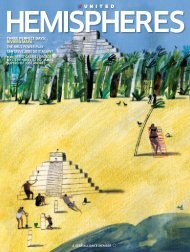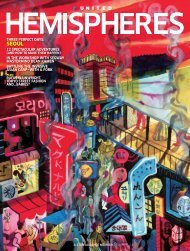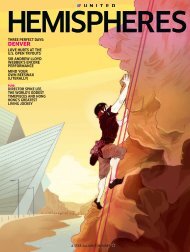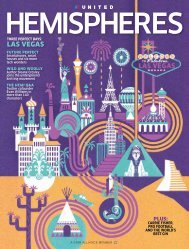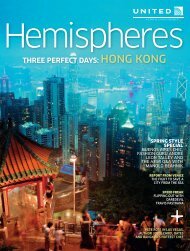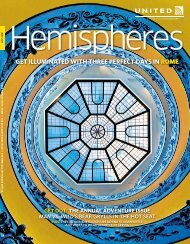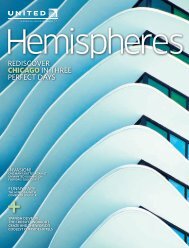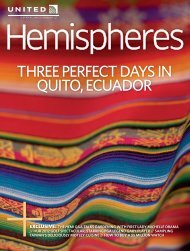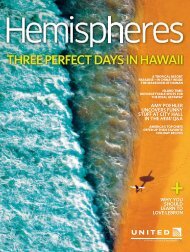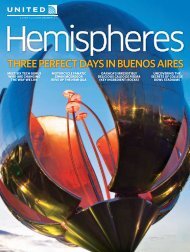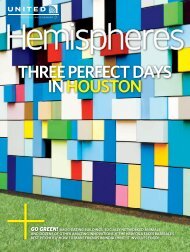june-2010
june-2010
june-2010
You also want an ePaper? Increase the reach of your titles
YUMPU automatically turns print PDFs into web optimized ePapers that Google loves.
So the police would wait for you outside. You’d leave the club,<br />
they’d take you to the police station, then you’d sleep over and<br />
go to court the following morning and pay the fi ne. You’d go<br />
back again to the club and do the same thing. It was a way<br />
of fi ghting the regime. We fought the system through our<br />
music—and through our persistence.”<br />
In the late ’50s and ’60s, as former Sophiatown residents<br />
dispersed into Meadowlands and other parts of Soweto,<br />
the African jazz of Masekela and Makeba drifted there too,<br />
evolving into a funkier, more rigidly rhythmic style known<br />
as mbaqanga, or township jive. Paul Simon tapped into<br />
this style on Graceland, collaborating with South African<br />
musicians such as Ladysmith Black Mambazo. From there,<br />
just as American funk morphed into hip-hop, township jive<br />
went electronic, fi rst as bubblegum, then as kwaito.<br />
One Saturday evening, Mduduzi Thusi, or Mdu, a 26-yearold<br />
Huddleston Centre tour guide who lives in Sophiatown,<br />
agrees to off er me a glimpse of how this music has evolved.<br />
We begin in Newtown, a rising Joburg neighborhood in<br />
which hip bars have opened in abandoned factories. An<br />
upscale restaurant here is actually called Sophiatown,<br />
and a wall mural inside depicts kids playing horns and<br />
pennywhistles. Outside, a plaque enshrines local jazz heroes<br />
such as Gwangwa and Masekela.<br />
As it happens, there’s no action in Newtown tonight—the<br />
Bassline club, which draws live rock and reggae bands, is<br />
closed till Monday, and the venerable Market Theatre is<br />
showing a play. So Mdu and his friend, Mpho, who drives<br />
HAVING A BALL<br />
Faces of the new<br />
Sophiatown<br />
a car with doors so rusted he describes it as a “moving<br />
sculpture,” take me to Soweto. This township is home to<br />
almost 900,000 residents, mostly black, who settled here<br />
during the apartheid era, when the government seized<br />
Johannesburg and the suburbs for themselves. We stop<br />
briefl y at Vilakazi Street, where Nelson Mandela lived in a<br />
tiny bungalow in the ’60s (it’s now a museum). Just down<br />
the street is Desmond Tutu’s former home.<br />
We pass shacks and shanties, house parties spilling into<br />
the streets and street-corner food joints, eventually arriving<br />
at News Café, a dance club in a strip mall on the edge of the<br />
township. Some 150 people are here, drinking and dancing<br />
to the thumping house music of regional acts like Durban’s<br />
Finest and Black Coff ee. I am the only white person here,<br />
and one of the few older than 25. Mdu and his friends grab a<br />
table, then haul me to the dance fl oor. Soon Mdu is clapping<br />
in my face, like a dance instructor, and a dozen clubgoers are<br />
demonstrating impossibly twisty steps and insisting I not<br />
deviate from “the beat! The beat!”<br />
This goes on until 2:30 a.m., by which point we are all<br />
drenched with sweat. Afterward, Mdu asks if I’ve found<br />
what I’m looking for. And while I’d actually pictured<br />
something more like a Hugh Masekela trumpet solo, the<br />
answer is defi nitely yes.<br />
Rolling Stone contributing editor STEVE KNOPPER has traveled everywhere<br />
from Nashville and Harlem to the Mississippi Delta, but he’s never<br />
come across a place like Sophiatown.<br />
5<br />
69



